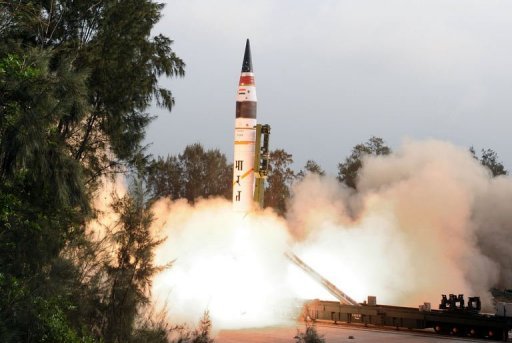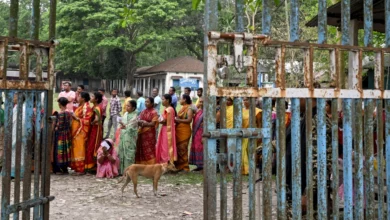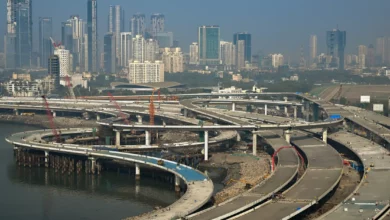
BHUBANESWAR, India — India on Thursday successfully test-fired a new missile capable of delivering a one-ton nuclear warhead anywhere in rival China, marking a major advance in its defense capabilities.
Watched by hundreds of scientists, the Agni V was launched from a test site off the eastern state of Orissa.
India views the rocket, which has a range of 5,000 km (3,100 miles), as a key boost to its regional power aspirations and one that narrows — albeit slightly — the huge gap with China's technologically advanced missile systems.
Prime Minister Manmohan Singh and Defense Minister A.K. Antony congratulated the nation's defense scientists on the "successful" launch, with Antony calling the achievement "a major milestone in India's missile program."
The test leaves India knocking at the door of a select club of nations with intercontinental ballistic missiles (ICBMs), which have a minimum range of 5,500 km.
Currently only the five permanent members of the UN Security Council — Britain, China, France, Russia and the United States — possess a declared ICBM capability.
"I am announcing the successful launch of Agni V… making history and making our country proud in the area of missile technology," V.K. Saraswat, head of India's Defense Research and Development Organization (DRDO) which made the missile, said.
He said India was now a "missile power."
DRDO spokesman Ravi Gupta insisted the Agni V was a "non country-specific" deterrent, but analysts noted it extends India's missile reach over the entire Chinese mainland, including military installations in the far northeast.
Agni, which means "fire" in Sanskrit, is the name given to a series of rockets India developed as part of its ambitious integrated guided missile development project launched in 1983.
While the shorter-range Agnis I and II were mainly developed with traditional rival Pakistan in mind, later versions with a range of 3,500 km — are perceived as China-centric deterrents.
A team of 800 have worked on the indigenously developed Agni V over the last three years, using new materials and technology to build motors capable of increasing the propulsion and speed of the new missile.
"Firstly you have a phenomenal range and so every single significant city — Beijing, Shanghai — will come within its range," retired Air Force officer Kapil Kak from the Center for Air Power Studies in India told AFP.
"Secondly, it has a very, very high speed compared to previous missiles… But the key issue is that this missile can be pushed to 8,000 km.
"The significance there is that India then demonstrates the capability to make an ICBM," he added.
There was no official reaction in China, but the state-run Global Times newspaper warned India "should not overestimate its strength" in an editorial published on Thursday.
"India should be clear that China's nuclear power is stronger and more reliable. For the foreseeable future, India would stand no chance in an overall arms race with China," it added.
The two Asian giants, each with a population of more than one billion, have prickly relations and a legacy of mistrust that stems from a brief but bloody border war in 1962.
In public, their leaders stress that trade is booming and that the world is big enough to accommodate both of them as they develop economically.
China's military arsenal is far larger and far more technologically advanced than India's, which is why the Agni V is so important, according to Monika Chansoria, a senior fellow at the Delhi-based Center for Land Warfare Studies.
"What this missile does is enable India to upgrade its present strategic posture towards countries like China from one of dissuasion to one of credible deterrence," Chansoria said.
Shannon Kile, an expert on nuclear weapons at the Stockholm International Peace Research Institute (SIPRI) think tank, said Agni V was partly a "prestige" development for India, supporting its aspirations to be global player.
The Agni V test came just weeks after India returned to the elite group of countries with a nuclear-powered submarine when it inducted a new vessel leased from Russia.




